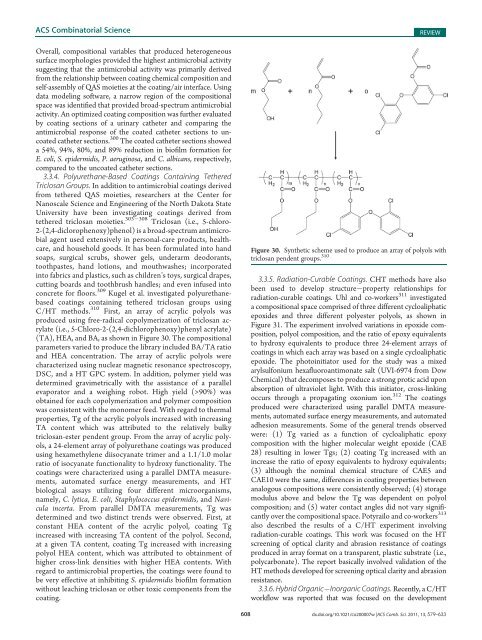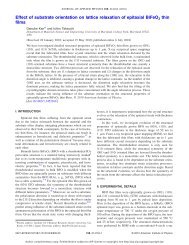Combinatorial and High-Throughput Screening of Materials ...
Combinatorial and High-Throughput Screening of Materials ...
Combinatorial and High-Throughput Screening of Materials ...
You also want an ePaper? Increase the reach of your titles
YUMPU automatically turns print PDFs into web optimized ePapers that Google loves.
ACS <strong>Combinatorial</strong> Science<br />
Overall, compositional variables that produced heterogeneous<br />
surface morphologies provided the highest antimicrobial activity<br />
suggesting that the antimicrobial activity was primarily derived<br />
from the relationship between coating chemical composition <strong>and</strong><br />
self-assembly <strong>of</strong> QAS moieties at the coating/air interface. Using<br />
data modeling s<strong>of</strong>tware, a narrow region <strong>of</strong> the compositional<br />
space was identified that provided broad-spectrum antimicrobial<br />
activity. An optimized coating composition was further evaluated<br />
by coating sections <strong>of</strong> a urinary catheter <strong>and</strong> comparing the<br />
antimicrobial response <strong>of</strong> the coated catheter sections to uncoated<br />
catheter sections. 300 The coated catheter sections showed<br />
a 54%, 94%, 80%, <strong>and</strong> 89% reduction in bi<strong>of</strong>ilm formation for<br />
E. coli, S. epidermidis, P. aeruginosa, <strong>and</strong> C. albicans, respectively,<br />
compared to the uncoated catheter sections.<br />
3.3.4. Polyurethane-Based Coatings Containing Tethered<br />
Triclosan Groups. In addition to antimicrobial coatings derived<br />
from tethered QAS moieties, researchers at the Center for<br />
Nanoscale Science <strong>and</strong> Engineering <strong>of</strong> the North Dakota State<br />
University have been investigating coatings derived from<br />
tethered triclosan moieties. 303 308 Triclosan (i.e., 5-chloro-<br />
2-(2,4-diclorophenoxy)phenol) is a broad-spectrum antimicrobial<br />
agent used extensively in personal-care products, healthcare,<br />
<strong>and</strong> household goods. It has been formulated into h<strong>and</strong><br />
soaps, surgical scrubs, shower gels, underarm deodorants,<br />
toothpastes, h<strong>and</strong> lotions, <strong>and</strong> mouthwashes; incorporated<br />
into fabrics <strong>and</strong> plastics, such as children’s toys, surgical drapes,<br />
cutting boards <strong>and</strong> toothbrush h<strong>and</strong>les; <strong>and</strong> even infused into<br />
concrete for floors. 309 Kugel et al. investigated polyurethanebased<br />
coatings containing tethered triclosan groups using<br />
C/HT methods. 310 First, an array <strong>of</strong> acrylic polyols was<br />
produced using free-radical copolymerization <strong>of</strong> triclosan acrylate<br />
(i.e., 5-Chloro-2-(2,4-dichlorophenoxy)phenyl acrylate)<br />
(TA), HEA, <strong>and</strong> BA, as shown in Figure 30. The compositional<br />
parameters varied to produce the library included BA/TA ratio<br />
<strong>and</strong> HEA concentration. The array <strong>of</strong> acrylic polyols were<br />
characterized using nuclear magnetic resonance spectroscopy,<br />
DSC, <strong>and</strong> a HT GPC system. In addition, polymer yield was<br />
determined gravimetrically with the assistance <strong>of</strong> a parallel<br />
evaporator <strong>and</strong> a weighing robot. <strong>High</strong> yield (>90%) was<br />
obtained for each copolymerization <strong>and</strong> polymer composition<br />
was consistent with the monomer feed. With regard to thermal<br />
properties, Tg <strong>of</strong> the acrylic polyols increased with increasing<br />
TA content which was attributed to the relatively bulky<br />
triclosan-ester pendent group. From the array <strong>of</strong> acrylic polyols,<br />
a 24-element array <strong>of</strong> polyurethane coatings was produced<br />
using hexamethylene diisocyanate trimer <strong>and</strong> a 1.1/1.0 molar<br />
ratio <strong>of</strong> isocyanate functionality to hydroxy functionality. The<br />
coatings were characterized using a parallel DMTA measurements,<br />
automated surface energy measurements, <strong>and</strong> HT<br />
biological assays utilizing four different microorganisms,<br />
namely, C. lytica, E. coli, Staphylococcus epidermidis, <strong>and</strong>Navicula<br />
incerta. From parallel DMTA measurements, Tg was<br />
determined <strong>and</strong> two distinct trends were observed. First, at<br />
constant HEA content <strong>of</strong> the acrylic polyol, coating Tg<br />
increased with increasing TA content <strong>of</strong> the polyol. Second,<br />
at a given TA content, coating Tg increased with increasing<br />
polyol HEA content, which was attributed to obtainment <strong>of</strong><br />
higher cross-link densities with higher HEA contents. With<br />
regard to antimicrobial properties, the coatings were found to<br />
be very effective at inhibiting S. epidermidis bi<strong>of</strong>ilm formation<br />
without leaching triclosan or other toxic components from the<br />
coating.<br />
REVIEW<br />
Figure 30. Synthetic scheme used to produce an array <strong>of</strong> polyols with<br />
triclosan pendent groups. 310<br />
3.3.5. Radiation-Curable Coatings. CHT methods have also<br />
been used to develop structure property relationships for<br />
radiation-curable coatings. Uhl <strong>and</strong> co-workers 311 investigated<br />
a compositional space comprised <strong>of</strong> three different cycloaliphatic<br />
epoxides <strong>and</strong> three different polyester polyols, as shown in<br />
Figure 31. The experiment involved variations in epoxide composition,<br />
polyol composition, <strong>and</strong> the ratio <strong>of</strong> epoxy equivalents<br />
to hydroxy equivalents to produce three 24-element arrays <strong>of</strong><br />
coatings in which each array was based on a single cycloaliphatic<br />
epoxide. The photoinitiator used for the study was a mixed<br />
arylsulfonium hexafluoroantimonate salt (UVI-6974 from Dow<br />
Chemical) that decomposes to produce a strong protic acid upon<br />
absorption <strong>of</strong> ultraviolet light. With this initiator, cross-linking<br />
occurs through a propagating oxonium ion. 312 The coatings<br />
produced were characterized using parallel DMTA measurements,<br />
automated surface energy measurements, <strong>and</strong> automated<br />
adhesion measurements. Some <strong>of</strong> the general trends observed<br />
were: (1) Tg varied as a function <strong>of</strong> cycloaliphatic epoxy<br />
composition with the higher molecular weight epoxide (CAE<br />
28) resulting in lower Tgs; (2) coating Tg increased with an<br />
increase the ratio <strong>of</strong> epoxy equivalents to hydroxy equivalents;<br />
(3) although the nominal chemical structure <strong>of</strong> CAE5 <strong>and</strong><br />
CAE10 were the same, differences in coating properties between<br />
analogous compositions were consistently observed; (4) storage<br />
modulus above <strong>and</strong> below the Tg was dependent on polyol<br />
composition; <strong>and</strong> (5) water contact angles did not vary significantly<br />
over the compositional space. Potyrailo <strong>and</strong> co-workers 313<br />
also described the results <strong>of</strong> a C/HT experiment involving<br />
radiation-curable coatings. This work was focused on the HT<br />
screening <strong>of</strong> optical clarity <strong>and</strong> abrasion resistance <strong>of</strong> coatings<br />
produced in array format on a transparent, plastic substrate (i.e.,<br />
polycarbonate). The report basically involved validation <strong>of</strong> the<br />
HT methods developed for screening optical clarity <strong>and</strong> abrasion<br />
resistance.<br />
3.3.6. Hybrid Organic Inorganic Coatings. Recently, a C/HT<br />
workflow was reported that was focused on the development<br />
608 dx.doi.org/10.1021/co200007w |ACS Comb. Sci. 2011, 13, 579–633












